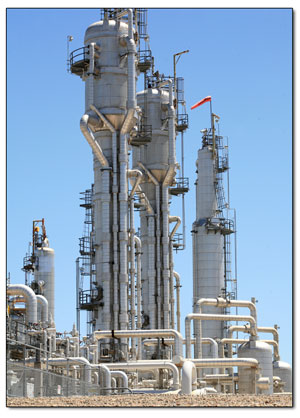 |
|
Unlike real estate values, which are based on a two-year average, oil and gas property values are assessed annually and are currently on the rise. This could provide La Plata County with a silver lining in its ongoing battle to balance the budget./Photo by Steve Eginoire |
La Plata silver linings
Oil, gas prices have potential to bring welcome revenue to county
by Tracy Chamberlin
They saw it coming. A decline in the bottom line that would affect La Plata County’s budget for at least the next couple of years.
A perfect storm of all-time low property values and reassessment numbers conspired to mak for a 2014 budget that needed to be trimmed to the tune of millions of dollars.
But, it turns out, there could be a silver lining to all those clouds.
The biggest piece of La Plata County’s revenue pie, property tax collections, is expected to drop by 17.5 percent in the new year, according to the 2014 budget.
That’s a loss of $3.3 million in the county’s operating budget.
The number is a direct result of property values hitting a low point in 2012 in both oil and gas and real estate.
The biggest contributor to the decline, however, is the falling price and decreasing production of natural gas.
“Gas is such a large part of our base,” said County Assessor Craig Larson.
In fact, oil and natural gas resources, including production and facilities, made up 46 percent of the revenues collected from property taxes in 2012.
That number dropped to 37 percent in 2013.
County officials were well aware of the pending revenue decline due to property tax assessments, even warning county commissioners that revenues for the 2014 budget would be down.
It’s also the reason why the bottom line for the 2014 budget is $2.4 million below what it was in 2013.
Along with attempting to tighten the budget, officials are also looking to technology in an attempt to increase efficiency. They also plan to apply for grants to add to the bottom line.
Another potential bright spot for La Plata County is sales tax. Although it is the county’s secondary source of revenue, it is on the rise.
As of July, the county was up 7 percent in sales tax revenues from 2012. The county budget, however, is only projecting a 3 percent increase for 2013.
But with their primary source of revenue hitting a low point, officials are looking at a loss of millions of dollars to the 2014 budget.
It turns out, the oil and gas side of things might actually come with a silver lining because the assessed values of oil and gas are annual, unlike real estate, which is biannual.
Property assessments for real estate are based on a two-year average market value. This year’s assessments were set during the time period from July 1, 2010 to June 30, 2012 when values were low, possibly at their lowest.
Oil and gas values, on the other hand, are assessed each year.
And the price of natural gas is on the rise.
Typically measured in cubic feet, natural gas was about $2.49 in 2012 and currently sits at about $3.31, according to Larson.
Like many communities across the county and the nation, natural gas had been providing revenue booms in the 2000s, but those numbers have been declining since they hit a high point in 2009 and 2010, likely hitting a low point in 2012.
The one element of the equation that could derail the oil and gas silver lining is depletion, which won’t be calculated until April, Larson said.
Similar to depreciation, it allows companies to account for the use of natural resources over time, and they have until the first quarter of 2014 to make those adjustments.
Also, not every part of the county will be affected the same way, it depends on where the oil and gas wells are located.
For example, the Ignacio School District would get more revenue from the tax pool because more oil and gas wells are located in the area.
Larson said the other side of the property value equation is facilities, such as pipes and equipment, which are becoming a larger and larger part of oil and gas property values.
It’s yet another changing element of the market. From real estate to oil and gas to agriculture, the recession had an impact on property values and how the market equations work.
For example, real estate prices in one area of the county saw dramatic declines while others are ahead of where they were before the recession.
Larson said the market is still unsteady, but it’s picking up. “That may have been our valley … the summer of 2012,” he added.
So, if La Plata County can find a way through the next couple of years, it just might make it through yet another perfect storm.
In this week's issue...
- January 25, 2024
- Bagging it
State plastic bag ban is in full effect, but enforcement varies
- January 26, 2024
- Paper chase
The Sneer is back – and no we’re not talking about Billy Idol’s comeback tour.
- January 11, 2024
- High and dry
New state climate report projects continued warming, declining streamflows
